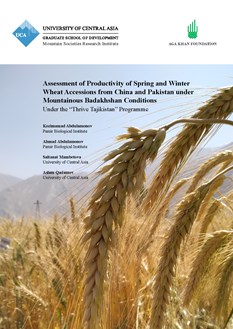Assessment of the Productivity of Spring and Winter Wheat Accessions from China and Pakistan under Mountainous Badakhshan Conditions
Wheat (Triticum aestivum L.) belongs to family Gramineae and tribe Hordeae. It is the third most important cereal crop in the world after rice and maize. Wheat is one of the most consumable cereal crops in Central Asia, and almost every meal includes bread, which is made of wheat.
This project’s goal was to assess foreign accessions from China and Pakistan that carried traits such as high yield, disease resistance, and short stem that would not lodge before harvest.
GBAO is a unique natural science laboratory where a number of crops are grown, including wheat (Vavilov N.I. 1964). In the 1950s, scientists tested foreign breeding lines in the Pamirs and found that their yield was less compared to the local varieties. These findings were confirmed by scientists from the Pamir Biological Institute (PBI) (Abdulamonov K., Bahronov A.Ya. et al., 2013).
PBI’s experimental station in Ishkashim district, where the research was carried out, is the only institution that has 17 ha of arable land, and their interest is in creating and saving local varieties and their gene pools (Figure 1-3). Currently, in the collection, there are more than 100 local wheat varieties, including 30 varieties from Badakhshan (15 from Tajikistan and 15 from Afghanistan). As a result of this work, hybrid lines that combined economically valuable traits have been created.




